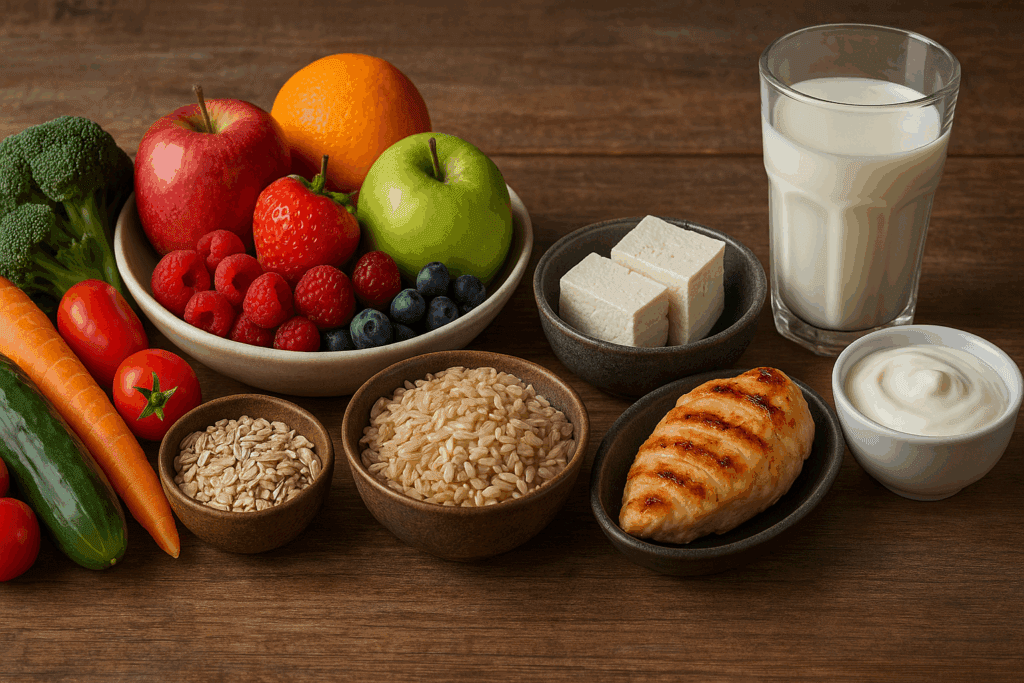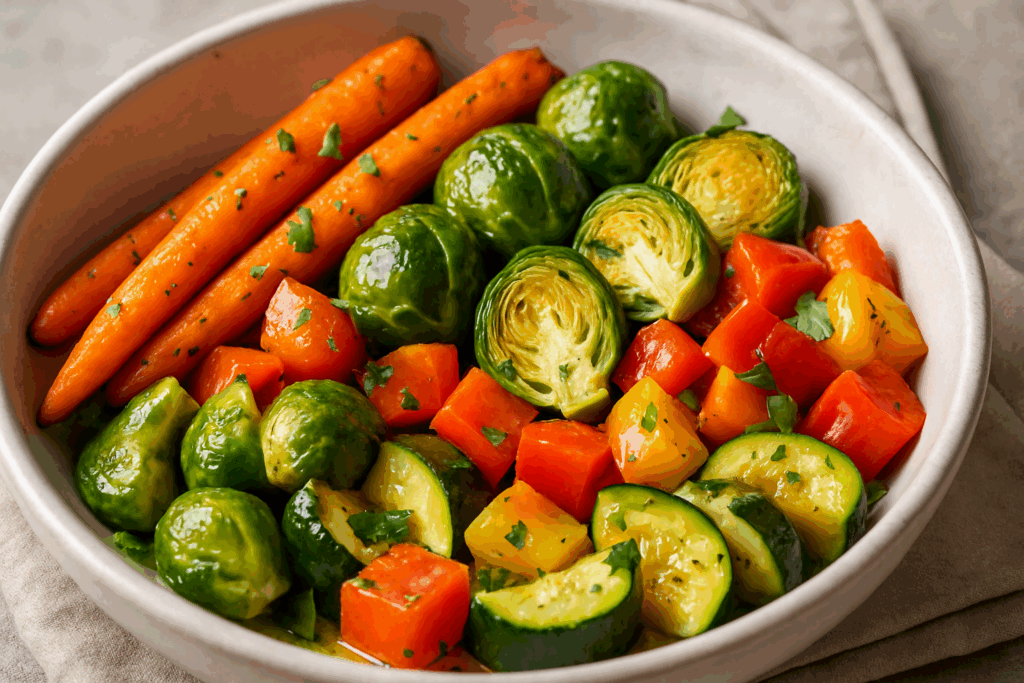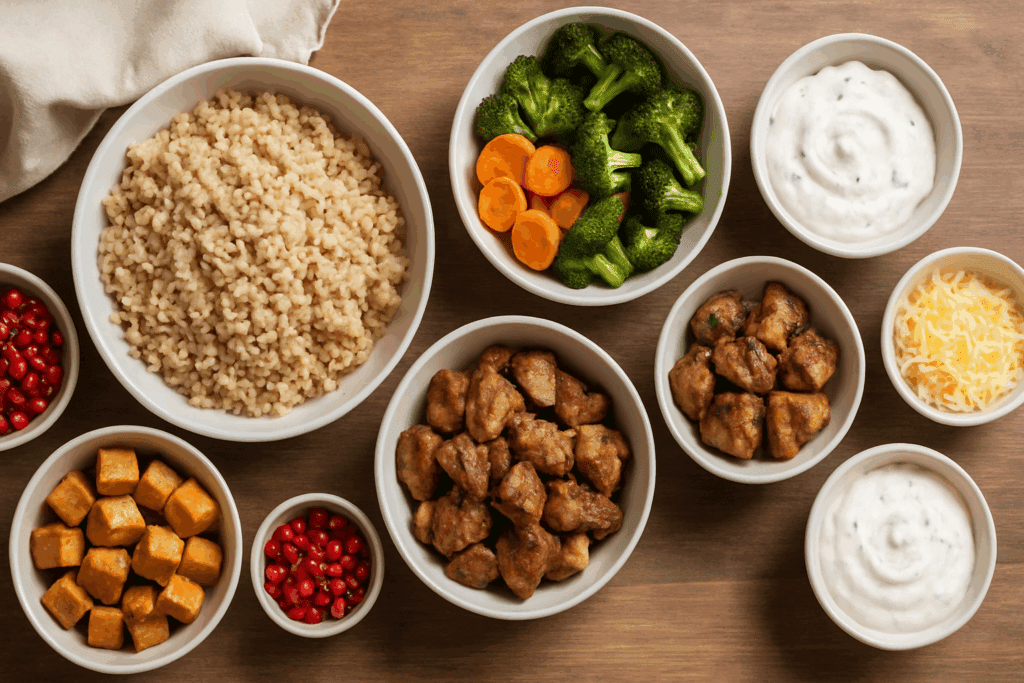In the world of nutrition, balance is everything. While food trends come and go, the fundamentals of a healthy diet remain rooted in one timeless principle: variety. The foundation of long-term wellness lies in consuming a wide range of nutrients that nourish every system of the body, and this is most effectively achieved by including all five essential food groups in your meals. When we consider dinner—the final substantial meal of the day—it becomes even more important to approach it with intentionality. A well-structured dinner using all five nutrients can fuel overnight repair, regulate blood sugar, and help us wind down without feeling overstuffed or deprived. In this comprehensive guide, we will explore how to create dinner ideas with all 5 food groups, combining scientific principles with practical advice to promote better health through balanced nutrition.
You may also like: Delicious Meets Nutritious: How to Create Healthy Food with Flavor Using Expert-Backed Diet Recipes and Cooking Tips

Understanding the Five Essential Food Groups
Before diving into meal planning strategies, it’s important to establish a clear understanding of what the five food groups are and why they matter. These groups—vegetables, fruits, grains, protein foods, and dairy—each contribute unique and essential nutrients that support a wide range of bodily functions. Vegetables provide fiber, antioxidants, and vitamins like A, C, and K, which are vital for immune defense, skin health, and cellular repair. Fruits add natural sugars, hydration, and phytonutrients that help prevent chronic diseases. Whole grains offer complex carbohydrates and B vitamins, supporting steady energy release and cognitive function. Proteins, whether plant-based or animal-derived, supply amino acids that help rebuild muscle tissue and regulate hormones. Finally, dairy products or fortified alternatives serve as key sources of calcium, vitamin D, and phosphorus—nutrients critical for bone strength and nerve transmission.
When all five of these food groups are represented in a dinner meal using all 5 nutrients, the body benefits from a symphony of nutritional support. Rather than focusing narrowly on calorie counts or fad-diet macros, this approach encourages a more holistic and sustainable style of eating that aligns with the latest in nutrition science.
Why Dinner Deserves Nutritional Diversity
Dinner is often the meal that gets sacrificed to convenience or emotional exhaustion. After a long day, it’s easy to reach for takeout, processed frozen meals, or snack foods lacking in real substance. Yet dinner is the ideal time to reset and recalibrate your nutritional goals. Not only does it provide a crucial opportunity to consume missed food groups from earlier in the day, but it also lays the groundwork for how you’ll sleep, how your body repairs tissues overnight, and how you’ll feel the next morning.
Meals that incorporate all five food groups at dinner tend to be more filling, reduce nighttime cravings, and promote healthier digestion. There’s also a psychological benefit to a colorful, well-rounded plate: it signals satisfaction to the brain, reducing the likelihood of overeating later. In terms of habit formation, the act of planning dinner ideas with all 5 food groups can encourage more mindful shopping, cooking, and family eating rituals. In a fast-paced world, these small acts can have lasting impacts on physical and emotional wellness.

Incorporating Vegetables Creatively in Evening Meals
Vegetables are arguably the most diverse and colorful category of the five food groups, and they are often underrepresented at dinner. Yet they are essential not only for their fiber content—which promotes satiety and digestive health—but also for their role in reducing inflammation and supporting the gut microbiome. One of the easiest ways to incorporate more vegetables into dinner is by using them as a base. Grain bowls with roasted vegetables, stir-fries with bok choy and bell peppers, or spaghetti squash tossed in tomato sauce are all examples of meals that begin with plants as the anchor.
Creativity goes a long way in encouraging regular vegetable intake. Roasting vegetables like carrots, zucchini, and Brussels sprouts with olive oil and herbs brings out their natural sweetness, making them more appealing to children and adults alike. Blending spinach or cauliflower into soups or sauces can sneak in an extra serving without altering taste or texture. Even non-traditional uses, like baking shredded zucchini into meatballs or using mushrooms as burger patties, can transform the way we see and taste vegetables. When building dinner ideas with all 5 food groups, vegetables should never be an afterthought—they should be a centerpiece of flavor and function.

Finding Balance with Fruits in Savory Dishes
While fruits are typically associated with breakfast or dessert, they can add dimension and nutritional value to dinner when used in savory applications. From a biochemical standpoint, fruits offer antioxidants such as polyphenols and flavonoids that help protect against oxidative stress—a condition linked to aging and chronic disease. Including fruits in a dinner meal using all 5 nutrients also supports hydration, thanks to their high water content, and can aid in digestion due to natural enzymes found in options like pineapple and papaya.
Culinary traditions across the globe incorporate fruit into main dishes with great success. Moroccan cuisine uses dried apricots and raisins in couscous and tagines. Latin American dishes may include mango salsa over grilled fish or pineapple with pork. Even Western cuisines use fruits like apples in pork chops or cranberries in grain salads. Pairing fruit with savory ingredients can create unexpected depth and natural sweetness without added sugars. Additionally, using fruit-based glazes or marinades can enhance flavor while boosting vitamin C intake, which supports iron absorption from protein-rich foods. Including fruits intentionally helps round out a dinner’s flavor profile while ensuring this food group is not neglected after lunch.
Choosing the Right Grains for Sustained Energy
Grains, particularly whole grains, provide complex carbohydrates that deliver energy in a slow and sustained manner. This is especially important for dinner, as blood sugar stability in the evening can influence sleep quality and hormonal balance. Unlike refined grains, whole grains retain the bran and germ, which are rich in fiber, magnesium, and B vitamins—all of which contribute to energy metabolism and cardiovascular health.
Examples of whole grains suitable for dinner include brown rice, quinoa, barley, bulgur, and farro. These grains can serve as the foundation of grain bowls, pilafs, or hearty soups. Even pasta can be a healthy grain choice if made from whole wheat or legume flours like chickpeas or lentils, offering additional fiber and protein. Grains also pair well with other food groups, absorbing sauces, seasonings, and fats that enhance their taste and texture. When constructing a dinner meal using all 5 nutrients, the inclusion of a whole grain component ensures lasting satiety and delivers essential micronutrients that are often missing in modern diets.
Protein Choices: The Building Blocks of Nutritional Repair
Protein foods play a fundamental role in muscle maintenance, immune support, hormone production, and enzyme function. They are the macronutrient most closely associated with structural repair, making them an indispensable part of a healthy dinner. Including protein in the evening helps regulate appetite overnight and supports muscle regeneration during sleep.
Both animal-based and plant-based proteins can be part of balanced dinner ideas with all 5 food groups. Lean options like grilled chicken, baked fish, turkey, or eggs offer high biological value proteins with essential amino acids. Plant-based alternatives such as tofu, tempeh, lentils, and beans provide fiber and phytonutrients along with protein, contributing to heart health and digestive efficiency. Nuts and seeds, while often categorized under fats, also contain protein and can add crunch or creaminess to meals when used in pestos, dressings, or toppings. Combining different protein sources, such as beans and rice or tofu with quinoa, ensures a broader spectrum of nutrients and amino acids.
Integrating Dairy or Dairy Alternatives for Bone and Muscle Health
Dairy is often overlooked in dinner meals, yet it offers a unique package of calcium, phosphorus, vitamin D, and high-quality protein. These nutrients are particularly important for bone density, nerve signaling, and muscle contractions. While many associate dairy with breakfast or dessert, incorporating it into dinner is not only possible but highly beneficial.
Greek yogurt sauces, cottage cheese sides, or shredded cheese toppings can easily be added to a variety of dishes without overwhelming the flavor profile. For those who are lactose intolerant or follow a plant-based diet, fortified plant milks like almond, soy, or oat can serve as suitable substitutes, provided they are enriched with calcium and vitamin D. Ricotta can be layered into pasta dishes or mixed into grain bowls for creaminess. Including dairy in a dinner meal using all 5 nutrients ensures that this food group is not relegated to the morning alone, and supports comprehensive nourishment across all stages of life.

Strategies for Creating Dinner Ideas with All 5 Food Groups
Bringing together all five food groups into one cohesive meal may seem daunting at first, but it becomes intuitive with a little practice. The key is to start with a foundational food, like a grain or vegetable, and build around it. For instance, beginning with a base of brown rice or quinoa, one can layer sautéed vegetables, a lean protein such as grilled salmon or lentils, a fruit-based salsa or garnish like mango or pomegranate seeds, and finish with a drizzle of yogurt-based dressing or crumbled cheese. This method ensures that each food group is thoughtfully included, rather than forced in at the end.
Another effective strategy is to think in terms of meal types that naturally support balance. Stir-fries, grain bowls, stuffed peppers, tacos, and casseroles all offer modular formats where different food groups can be layered in without much effort. Planning ahead by preparing vegetables or cooking grains in bulk can also streamline the dinner-making process. With intentional design, dinner ideas with all 5 food groups become a seamless and rewarding practice rather than a rigid rule.

Practical Tips for Busy Weeknights and Families
For many, the biggest challenge to eating balanced dinners isn’t lack of knowledge—it’s lack of time. Between work, commuting, and family responsibilities, the dinner hour can feel chaotic. However, there are ways to make healthy dinners practical even on the busiest of nights. Batch cooking is one of the most effective techniques. By preparing large portions of grains, proteins, and vegetables ahead of time, assembling a quick, nutrient-rich meal takes mere minutes. Slow cookers and pressure cookers can also be invaluable tools for creating soups, stews, and one-pot meals that include all five food groups.
Involving the whole family in dinner prep can also reduce time while encouraging healthy habits in children. Letting kids help wash vegetables, stir sauces, or plate dishes creates ownership and makes them more likely to eat what’s served. Using theme nights—like Mediterranean Mondays or Taco Tuesdays—can provide structure without monotony. With the right approach, creating a dinner meal using all 5 nutrients becomes not just manageable, but enjoyable.
Cultural Inspiration for Balanced Global Meals
Across cultures, traditional diets often reflect deep-rooted nutritional wisdom that aligns with modern principles of balance. Japanese meals, for instance, often include miso soup (vegetables, grains), grilled fish (protein), a side of rice, pickled vegetables, and fruit—all five food groups in one sitting. Mediterranean diets include olive oil-dressed vegetables, legumes or seafood, whole grain couscous, a bit of cheese, and fresh fruit. These global cuisines can serve as inspiration for building healthy dinners that feel both nourishing and exciting.
By drawing on cultural traditions, we also expand our palate, reduce food fatigue, and discover new cooking techniques that make balanced eating more enjoyable. Exploring global food practices reveals how dinner ideas with all 5 food groups have existed for centuries—long before food pyramids or dietary guidelines were formalized.
How Balanced Dinners Support Long-Term Health
Regularly consuming dinners with all five food groups has benefits that go beyond nightly nourishment. Over time, this approach supports cardiovascular health by increasing fiber and reducing saturated fats. It stabilizes blood sugar, lowers the risk of nutrient deficiencies, supports brain health through essential fats and vitamins, and even improves mood through stable serotonin production linked to amino acids and complex carbs.
The synergistic effects of combining all five food groups at dinner extend to disease prevention, weight management, and overall vitality. No single food group can provide everything the body needs, and when they work together, the nutritional outcome is significantly more powerful than the sum of its parts. Creating a dinner meal using all 5 nutrients becomes an act of preventative medicine, rooted in pleasure and practicality rather than restriction.
Frequently Asked Questions: Building Balanced Dinners with All Five Food Groups
1. What are some overlooked strategies for consistently creating dinner ideas with all 5 food groups?
One often-overlooked strategy is to use theme-based planning that automatically encourages inclusion of all five food groups. For example, Mediterranean-inspired dinners naturally include vegetables, whole grains like bulgur, lean proteins such as grilled fish or legumes, fruit-based sauces, and cheese or yogurt. Another method is using modular “build-your-own” meals—such as wraps, tacos, or grain bowls—where you can prep each component from a different food group. For families, integrating small portions of each group onto a divided plate can visually reinforce balance. Over time, these strategies transform the idea of a balanced dinner into a habit, making dinner ideas with all 5 food groups more of a mindset than a task.
2. Can I still build a dinner meal using all 5 nutrients if I follow a plant-based or vegan diet?
Absolutely. A well-planned vegan dinner can easily include all five food groups. Instead of traditional dairy, opt for fortified plant-based milks or yogurt alternatives to fulfill the dairy component. Protein can come from beans, tofu, tempeh, or lentils, while whole grains like quinoa, farro, or brown rice serve as your grain base. Roasted or steamed vegetables and a fruit component—like sliced oranges or a mango-lime salsa—round out the rest. With thoughtful substitutions, it’s entirely possible to develop dinner ideas with all 5 food groups without relying on animal products.
3. How can dinner ideas with all 5 food groups help reduce stress or improve mental wellness over time?
Nutrition has a significant influence on mood and stress resilience. Meals that include all five food groups promote better blood sugar regulation, which in turn stabilizes energy and mood. A dinner meal using all 5 nutrients ensures adequate intake of omega-3s (from fish or flax), magnesium (from leafy greens and whole grains), and B vitamins (from proteins and dairy), all of which are associated with improved neurological health. The routine of preparing a balanced dinner can also act as a calming, meditative ritual, providing structure and a sense of control in otherwise chaotic schedules. Over time, these practices build emotional resilience and support long-term mental well-being.
4. What are common mistakes people make when trying to build a dinner meal using all 5 nutrients?
One of the most frequent mistakes is overemphasizing one or two food groups while neglecting the rest. For instance, someone might load up on protein and grains but forget fruit altogether. Another common issue is using overly processed or sugary options to satisfy certain groups—like fruit juices instead of whole fruits or refined grains instead of whole grains. Others mistakenly assume that adding a multivitamin can replace the need for real food variety. To truly benefit from dinner ideas with all 5 food groups, focus on whole, minimally processed ingredients and proper portion balance rather than just checking off categories.
5. Are there innovative technologies or meal delivery services that promote dinners using all five food groups?
Yes, emerging meal delivery services are increasingly designed with whole-nutrition principles in mind. Some companies now offer meal kits that highlight a complete nutrient breakdown, ensuring every dish includes components from each of the five groups. Apps powered by AI are also beginning to recommend recipes based on a user’s dietary needs, lifestyle, and nutritional gaps. Smart kitchen scales and nutrition-tracking devices now integrate with apps to assess whether your dinner meets full nutrient spectrum requirements. These tools are becoming valuable allies for those trying to design dinner ideas with all 5 food groups without added mental strain.
6. How does including all 5 food groups at dinner affect sleep and nighttime recovery?
A dinner meal using all 5 nutrients plays a subtle but critical role in optimizing sleep quality and overnight physiological repair. The presence of complex carbohydrates helps facilitate the production of serotonin, a precursor to melatonin, which regulates sleep. Proteins supply amino acids necessary for muscle recovery, while dairy products contribute tryptophan and magnesium, known to support deeper rest. Fruits and vegetables add hydration and antioxidants, helping to reduce cellular stress that accumulates during the day. This harmony among nutrients enhances parasympathetic nervous system function, promoting calm and restorative sleep patterns over time.
7. What cultural approaches can inspire dinner ideas with all 5 food groups?
Looking beyond Western norms can offer fresh inspiration. In Japanese cuisine, a typical dinner might include miso soup (vegetables and fermented protein), rice (grain), grilled fish (protein), seaweed salad (vegetable), and fruit for dessert. Indian thali meals traditionally provide lentils, whole grains, dairy in the form of yogurt, sautéed vegetables, and a small piece of fruit or chutney. These cultural patterns naturally align with the goal of a dinner meal using all 5 nutrients. Drawing on international traditions broadens flavor palettes and helps make balanced eating more enjoyable, diverse, and culturally respectful.
8. How can parents encourage children to enjoy dinner meals using all 5 nutrients without forcing them?
Creating a positive food environment is essential. Rather than pressuring children to eat everything on their plate, involve them in the shopping and cooking process. Let them help assemble their own mini grain bowls or tacos, choosing one ingredient from each food group. Incorporate fun presentations like fruit skewers or vegetable “noodles” to spark curiosity. Reinforce the idea that colorful plates mean stronger bodies and sharper minds. With repetition and gentle exposure, kids begin to recognize dinner ideas with all 5 food groups as the norm—building healthy preferences that often last into adulthood.
9. What role do fermented foods play in enhancing the benefits of a dinner meal using all 5 nutrients?
Fermented foods—such as kefir, yogurt, kimchi, and miso—can act as functional enhancers in balanced meals. Though not considered a distinct food group, they can complement several of the five groups simultaneously. For example, yogurt counts as dairy and also introduces beneficial probiotics that aid digestion and nutrient absorption. Fermented vegetables, like sauerkraut, can boost the impact of the vegetable category by improving gut flora diversity. Including these foods in dinner ideas with all 5 food groups not only amplifies their nutritional profile but may also increase the bioavailability of vitamins and minerals across the entire meal.
10. How can individuals with chronic conditions (like diabetes or hypertension) adapt dinner ideas with all 5 food groups safely?
The key is personalized substitution while preserving food group integrity. For someone managing diabetes, incorporating low-glycemic fruits like berries and grains like barley can help maintain blood sugar control. Individuals with hypertension might favor low-sodium dairy options and potassium-rich vegetables like spinach. Lean proteins and heart-healthy fats from nuts and legumes can be emphasized over red meats. A dinner meal using all 5 nutrients remains entirely feasible with adjustments tailored to one’s condition, especially when overseen by a registered dietitian. Such adaptations ensure that therapeutic needs are met without sacrificing the balance or enjoyment of a complete meal.
A Nourishing Ending: The Lasting Value of Dinner with All Five Food Groups
Incorporating all five food groups into your evening meal isn’t just about checking boxes—it’s about creating a dinner experience that nurtures the body, supports long-term health, and fosters a sustainable relationship with food. By thoughtfully combining vegetables, fruits, grains, proteins, and dairy or their alternatives, we provide our bodies with the essential tools for repair, energy, and balance. These dinner ideas with all 5 food groups aren’t fads or fleeting trends—they’re foundational practices that align with both cultural heritage and modern nutritional science.
Eating a dinner meal using all 5 nutrients is an achievable goal, even on busy weeknights, with the right mindset and preparation. Whether you’re cooking for one or feeding a family, this practice encourages variety, creativity, and a deeper appreciation for food’s role in wellness. In the end, every plate is an opportunity—to support your health, connect with others, and enjoy the fullness of a meal that’s truly complete.
Further Reading:
10 Simple Dinner Ideas for Healthy Eating in Real Life
91 Healthy Recipes That Need Only 5 Ingredients (or Less!)


